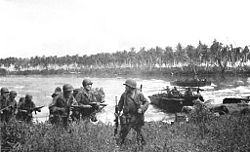Bismarck Archipelago
The Bismarck Archipelago is a group of islands off the northeastern coast of New Guinea in the western Pacific Ocean and part of Papua New Guinea.
History
The first inhabitants of the archipelago arrived around 33,000 years ago after they sailed from what is now Papua New Guinea. Later arrivals included the Lapita people.
The first European to visit the islands was the Dutch explorer Willem Schouten in 1616.[1][2]
The islands remained unsettled by Western Europeans until they became part of the German protectorate of German New Guinea in 1884. The area was named after German Chancellor Otto von Bismarck.
On 13 March 1888, a volcano erupted on Ritter Island causing a megatsunami. Almost all of the volcano fell into the ocean, which left a small lake in the volcanic crater.[3]
Afer the outbreak of World War I, the Australian Naval and Military Expeditionary Force seized the islands in 1914 and Australia later received a League of Nations mandate for the islands. They remained under Australian control (interrupted only by the Japanese occupation during World War II) until Papua New Guinea became independent in 1975.
Bismarck Archipelago Media
The first wave of US troops lands on Los Negros, Admiralty Islands, 29 February 1944.
Islands of the Bismarck Archipelago (shown in red) within the Provinces of Papua New Guinea.
Rabaul caldera, New Britain
Notes
- ↑ Sigmond,J.P and Zuiderbann, L.H.(1976) Dutch Discoveries of Australia, Rigby, Australia. ISBN 07270 08005
- ↑ Spate, O.H.K. (1979) The Spanish Lake, Australian National University, Second Edition, 2004. ISBN 1920942 173
- ↑ Ward, Steven N.; Day, Simon (September 2003). "Ritter Island Volcano —lateral collapse and the tsunami of 1888". Geophysical Journal International. Doi Publishing. 154 (3): 891–902. doi:10.1046/j.1365-246X.2003.02016.x. Retrieved 2007-12-17.
In the early morning of 1888 March 13, roughly 5 km3 of Ritter Island Volcano fell violently into the sea northeast of New Guinea. This event, the largest lateral collapse of an island volcano to be recorded in historical time, flung devastating tsunami tens of metres high on to adjacent shores. Several hundred kilometres away, observers on New Guinea chronicled 3 min period waves up to 8 m high, that lasted for as long as 3 h. These accounts represent the best available first-hand information on tsunami generated by a major volcano lateral collapse. In this article, we simulate the Ritter Island landslide as constrained by a 1985 sonar survey of its debris field and compare predicted tsunami with historical observations. The best agreement occurs for landslides travelling at 40 m s-1, but velocities up to 80 m s-1 cannot be excluded. The Ritter Island debris dropped little more than 800 m vertically and moved slowly compared with landslides that descend into deeper water. Basal friction block models predict that slides with shorter falls should attain lower peak velocities and that 40+ m s-1 is perfectly compatible with the geometry and runout extent of the Ritter Island landslide. The consensus between theory and observation for the Ritter Island waves increases our confidence in the existence of mega-tsunami produced by oceanic volcano collapses two to three orders of magnitude larger in scale.
Bibliography
- Firth, Stewart (1983). New Guinea Under the Germans. Carlton, Australia: Melbourne University Press. ISBN 0522842208.
- Howe, K. R., Robert C. Kiste, Brij V. Lal, eds. (1994). Tides of History: The Pacific Islands in the Twentieth Century. Honolulu: University of Hawaii Press. ISBN 0824815971.
- King, David et al. (1982). Papua New Guinea Atlas: A Nation in Transition. Bathurst, Australia: R. Brown and the University of Papua New Guinea. ISBN 0909197148.
- Moore, Clive (2003). New Guinea: Crossing Boundaries and History. Honolulu: University of Hawaii Press. ISBN 0824824857.
- Ryan, Peter, ed. (1972). Encyclopedia of Papua New Guinea. 3 volumes; Vol I: A - K, maps, black and white illustrations, xv + 588pp. Vol II: l - Z, maps, black and white illustrations, 589-1231pp. Vol III: Index, folding colour map in rear pocket, map, colour illustration, v + 83pp. Carlton, Australia: Melbourne University Press. ISBN 9780522840254.
Other websites
| Wikimedia Commons has media related to Lua error in Module:Commons_link at line 62: attempt to index field 'wikibase' (a nil value).. |
- about the provinces Archived 2007-05-20 at the Wayback Machine
Coordinates: 5°00′S 150°00′E / 5.000°S 150.000°E


